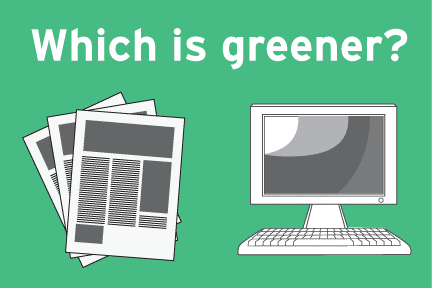
Is Digital Media Really Greener Than Print?
These days everyone seems to understand that wasted paper is bad for the environment. Therefore “going paperless,” or bringing formerly printed materials onto the web, is inherently a greener solution. Or is it? In his recent eye-opening article, “Is Digital Media Worse for the Environment than Print?,” Don Carli, senior research fellow at the Institute for Sustainable Communication, alerts the public to the unseen and largely unreported environmental impacts of digital media. He urges us to look beyond “green rhetoric,” and to consider the harmful effects of the digital supply chain in order to make informed decisions.
The Problem
Most energy used to power digital technology in the U.S. comes from coal-fired power plants. This coal is mined from mountaintops, which is a MAJOR cause of deforestation, destruction of ecosystems, pollution, and the emission of greenhouse gases contributing to global warming. Energy consumption is increasing at an exponential rate. Consider some of these mind-blowing statistics and hypotheses that Carli sites in his article:
1. “Greenpeace estimates that by 2020, data centers will demand more electricity than is currently demanded by France, Brazil, Canada and Germany combined.”
2. The U.S. department of Energy states that electricity consumed by United States data Centers doubled between 2000 and 2006 and is expected to double again by 2011. This is equal to 60 billion kilowatt hours per year or the amount of electricity used by over half a million homes in one year!
The Big Picture Solution-What Can be Done on a Government Level?
This seems to be another case of the modern-age problem of the need to invest in renewable energy sources. Power plants must move away from coal and utilize alternative renewable energy sources such as forest biomass to generate electricity. For those of you who are rusty on your environmental science, biomass is derived from the forest residues of dead trees, branches, and other plant and animal matter. Biomass could then be combined with wind and solar energy to power plants.
I wonder what the government is doing now to combat this issue. Will there be eventual legislation to outlaw mountain-top coal mining? What percentage of power plants are currently using biomass to generate electricity?
The Small Picture Solution-What can we as Individuals do on a Day to Day Basis?
Although Carli constantly refers to making “informed decisions” he doesn’t go into much detail about what these decisions are or entail. He does quickly mention that when purchasing paper, one should consider buying brands that employ biomass, but as far as digital media goes, I have a lot of questions about what I as an individual can actually do. One of my main questions is: Can we as individuals or communities have any control over where we get electricity from or where our data is processed?
The article is more of a scary wake-up call and less of a call-to-action. (by no means bad, since it motivates me to do research.) Of course, generating awareness is the first step towards widespread adoption of new energy practices.
Visit “What’s My Connection to Mountaintop Removal?” to find out how much of the energy you use comes from mountaintop coal.
-Ryan Nussbaum

